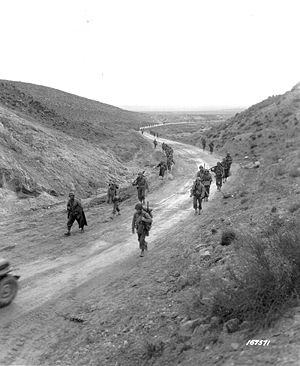Battle of Kassarine Pass
| Battle of Kasserine Pass | |||||||
|---|---|---|---|---|---|---|---|
| Part of the Tunisia Campaign of World War II | |||||||
 Men of the 2nd Battalion, 16th Infantry Regiment of the U.S. 1st Infantry Division march through the Kasserine Pass and on to Kasserine and Farriana, Tunisia February 26, 1943. |
|||||||
|
|||||||
| Belligerents | |||||||
|
|
|
||||||
| Commanders and leaders | |||||||
|
|
|
||||||
| Strength | |||||||
| 30,000 | 22,000 | ||||||
| Casualties and losses | |||||||
|
Including Sidi Bou Zid:
|
Including Sidi Bou Zid: 2,000 34 tanks |
||||||
Including Sidi Bou Zid:
10,000
183 tanks
American
The Battle of Kasserine Pass was a battle of the Tunisia Campaign of World War II that took place in February 1943. Kasserine Pass is a 2-mile-wide (3.2 km) gap in the Grand Dorsal chain of the Atlas Mountains in west central Tunisia. The Axis forces, led by Generalfeldmarschall Erwin Rommel, were primarily from the Afrika Korps Assault Group, elements of the Italian Centauro Armoured Division and two Panzer divisions detached from the 5th Panzer Army, while the Allied forces consisted of the U.S. II Corps (Major General Lloyd Fredendall), the British 6th Armoured Division (Major-General Charles Keightley) and other parts of the First Army (Lieutenant-General Kenneth Anderson).
The battle was the first major engagement between American and Axis forces in World War II in Africa. Inexperienced and poorly led American troops suffered many casualties and were quickly pushed back over 50 miles (80 km) from their positions west of Faïd Pass. After the early defeat, elements of the U.S. II Corps, with British reinforcements, rallied and held the exits through mountain passes in western Tunisia, defeating the Axis offensive. As a result of the battle, the U.S. Army instituted sweeping changes of unit organization and replaced commanders and some types of equipment.
...
Wikipedia
